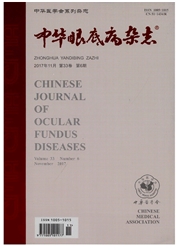

 中文摘要:
中文摘要:
目的观察典型性脉络膜新生血管(CNV)的荧光素眼底血管造影(FFA)与吲哚青绿血管造影(ICGA)图像特征的异同。方法回顾分析34例(36只眼)典型性CNV患者的FFA和ICGA检查资料,并将FFA与ICGA结果进行对比分析。结果FFA显示典型性CNV的早期形态,在15只AMD患眼中有3只眼呈绒团状或车辐状轮廓,占20%;7只病理性近视患眼中有5只眼呈绒团状,占71.4%;14只中心性渗出性脉络膜视网膜病变中有9只眼呈绒团状,占64.3%。36只典型性CNV患眼,ICGA显示清楚的CNV20只眼,占55.6%;ICGA显示欠清楚的CNV15只眼,占41.6%;ICGA未能发现CNV的1只眼,占2.8%;ICGA可显示FFA不能显示的滋养血管6只眼,占16.7%。结论典型性CNV的FFA早期形态,AMD中多呈不规则形,而病理性近视和中心性渗出性脉络膜视网膜病变以绒团状居多。ICGA显示典型性CNV的轮廓边界不如FFA清楚,但可发现FFA显示不出的滋养血管。
 英文摘要:
英文摘要:
Objective To compare the characteristics of the results of fundus fluorescein angiography (FFA) and indocyanine green angiography (ICGA) in patients with classic choroidal neovasculazation (CNV). Methods The data of FFA and ICGA of 34 patients (36 eyes) with classic CNV were analyzed retrospectively and the results of the two examinations were analyzed contrastively. Results The results of FFA revealed the clew or cartheel-tike configuration of classic CNV at the early phase in 3 out of 15 eyes (20%) with age-related macular degeneration (AMD); in 5 out of 7 eyes with pathological myopia (71.40%); and in 9 out of 14 eyes with central exudative chorioretinopathy (CEC), (64.3%) ,In 36 eyes with classic CNV, the images of ICGA indicated CNV distinctly in 20 (55.6%) and indistinctly in 15 (41.6%); CNV was not detected by ICGA in 1 eye (2.8%); feeding blood vessels in 6 eyes (16. 7%) were detected by ICGA but none by FFA. Conclusions At the early phase of FFA, the configuration of classic CNV is clew-like in eyes with pathological myopia and CEC, and erose in eyes with AMD. The image of ICGA which indicated the outline of classic CNV is not as clear as the one of FFA, but it can reveal the feeding vessels which FFA can not.
 同期刊论文项目
同期刊论文项目
 同项目期刊论文
同项目期刊论文
 期刊信息
期刊信息
